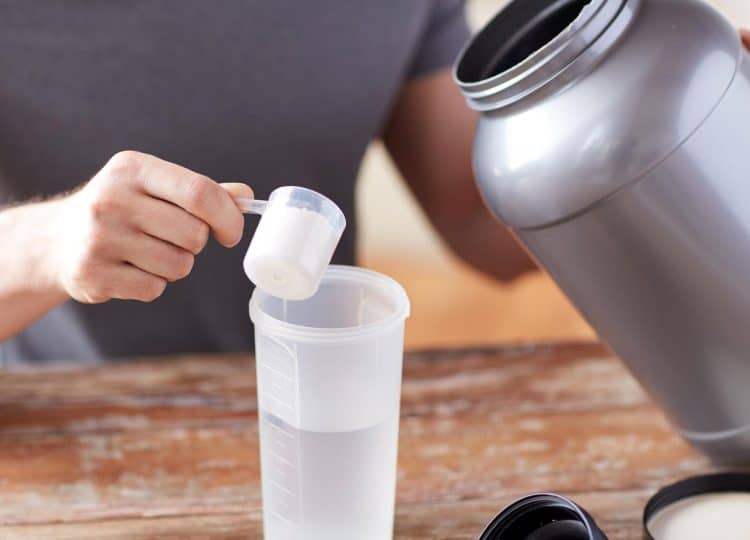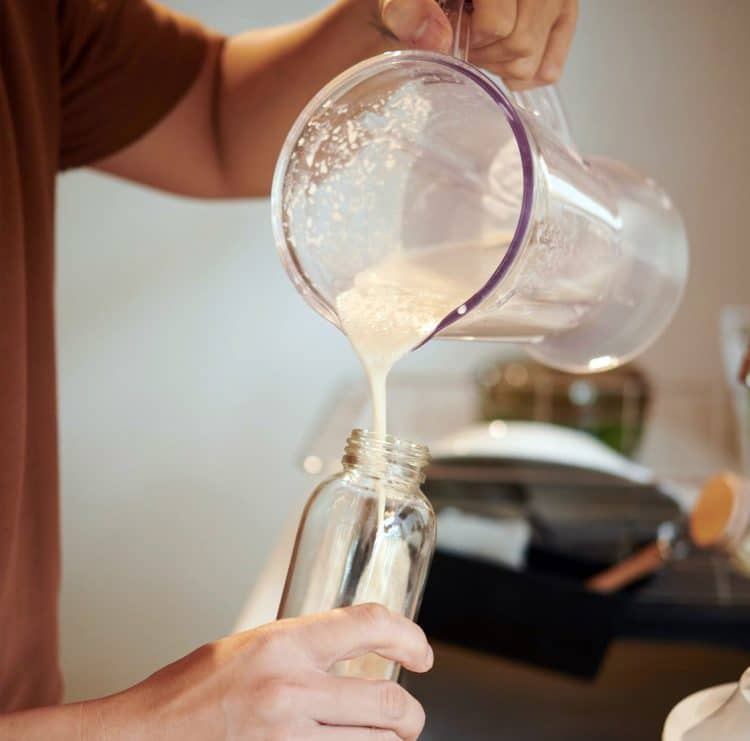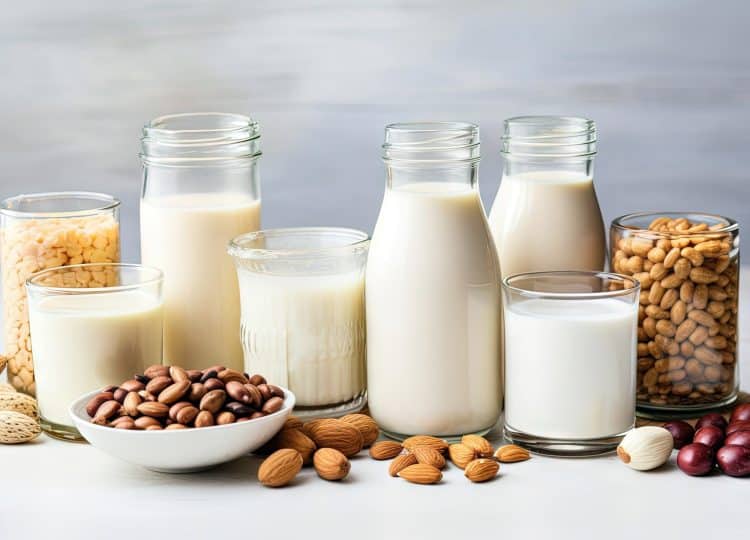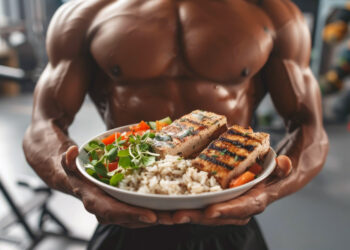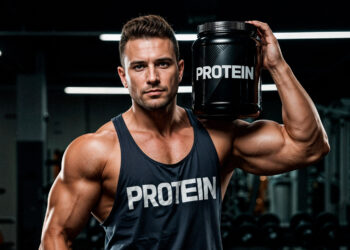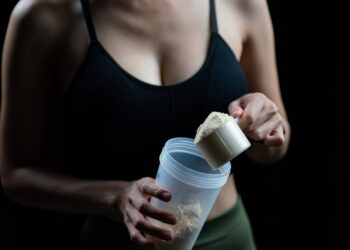Navigating the world of fitness and nutrition, many individuals grapple with the decision of whether to mix their protein powder with milk or water. This seemingly simple choice can have significant implications on your health goals—be it weight loss, muscle building, or maintenance.
As an FNTP-qualified nutritionist deepening my expertise through a Master’s in Clinical Nutrition, I blend evidence-based practices with naturopathic principles to guide clients toward optimal health.
Choosing between milk and water for your protein shake hinges not only on taste but also on nutritional strategies tailored to individual needs. Milk enriches shakes with additional proteins, fats, and carbohydrates, which might benefit those seeking extra calories and nutrients for muscle growth.
Conversely, water is the go-to for low-calorie diets aimed at fat loss. Understanding these nuances is key—and this article promises to illuminate them clearly. Uncover the best mix for you!
Key Insights
- Milk adds extra protein, fats, and carbs to shakes, which can help with muscle growth but may not be good for weight loss.
- Water is a low-calorie option that helps your body absorb protein fast and fits well in many diets.
- Your choice between milk or water should match your fitness goals, taste preference, and how your stomach feels after drinking it.
- Mix in fruits or nut butter to make shakes tastier and more nutritious; consider what you need after workouts for the best recovery.
Nutritional Differences: Mixing Protein Powder with Milk vs. Water
Mixing protein powder with milk increases the overall protein content and adds essential nutrients. However, it also introduces more fats and carbohydrates. These additional elements could slow the absorption of protein. On the other hand, using water results in a lower-calorie shake. Water-based shakes may be absorbed more quickly by the body.
Level Up Your Fitness: Join our 💪 strong community in Fitness Volt Newsletter. Get daily inspiration, expert-backed workouts, nutrition tips, the latest in strength sports, and the support you need to reach your goals. Subscribe for free!
Increased protein content in milk
Milk adds more protein to your shake. If you use whole milk or skimmed milk, you get extra grams of protein along with the whey protein from your powder. This helps if you want to build muscle mass or need more protein in your diet.
Cow’s milk comes packed with nutrients like calcium and vitamin D that help keep bones strong [1].
Choosing milk for your protein shakes is also smart when you’re not trying to cut calories. It can make your drink taste better because it’s creamy. For those lifting weights or doing a lot of exercise, the added calories from the milk can give extra energy and help with gaining weight and building lean muscle mass.
Additional fats and carbohydrates in milk
Pouring milk into your protein shake adds more than just a creamy texture. Milk comes with its own fats and carbohydrates. These extras can be good for people trying to build muscles or gain weight because they give the body more fuel.
But if you’re dieting or on a calorie-deficit diet, these added calories might not fit with your goals.
Keep in mind that milk’s extra carbs are mostly sugars, like lactose. If you are lactose intolerant or following low-carb diets, such as the ketogenic diet, mixing protein powder with water might be better for you.
Using water keeps things simple without the added sugars and fats from milk that could upset your stomach or get in the way of losing weight.
Slower absorption with milk
Milk makes your protein shake take longer for your body to use. This is because milk has extra stuff like fat and sugar that slow down digestion. When you drink a protein shake with milk, it moves slower through your stomach.
Your muscles get the protein more slowly. This can be good if you want to feel full for a long time or need nutrients over many hours, like when sleeping.
Choosing milk for your shake also means you give your body more calories and nutrients to help build muscle after working out hard. But remember, this might not be the best if you’re trying to cut back on calories or lose weight.
It’s all about what fits best with how you eat and exercise.
Benefits of mixing protein powder with water
Mixing protein powder with water is a quick and easy way to get your dietary protein without extra calories. It’s great for weight management because it adds no fats or milk sugars.
You can drink a whey protein shake after exercising and not worry about adding more calories from dairy products. This makes it perfect for people who want low carbs but still need high protein to meet their fitness goals.
Plus, water does not slow down digestion like milk can, so your body gets those amino acids faster.
Using water also means you avoid issues if you are lactose intolerant or don’t want extra saturated fat in your diet. It’s a simple choice that keeps your calorie count low while giving you the benefits of dietary supplements like whey isolate or concentrate.
Water mixed with protein powder fits well into many diets and helps keep your nutrition on track throughout the day.
Factors to Consider When Choosing Between Milk and Water
Deciding between milk and water for your protein shake hinges on personal goals, dietary needs, and taste preferences. Understanding these variables can guide you to the ideal mixer for your nutritional journey.
Explore how each choice aligns with your fitness regimen for optimized results.
Fitness goals and dietary restrictions
Your fitness goals are important when choosing between mixing protein powder with milk or water. If you want to gain muscle, adding milk gives extra calories and nutrients that help muscles grow.
Milk has more proteins and essential minerals, which can be good for building a strong body. But if your goal is to lose weight, using water helps avoid extra calories from the fats in milk.
Some people have dietary restrictions like lactose intolerance or choose not to drink dairy for personal reasons. They might use plant-based milk instead of dairy milk. Plant-based milks like soy, almond, or coconut also add different flavors and nutritional benefits to shakes without the problems dairy causes some people’s stomachs.
Always pick what matches your body needs and keeps you feeling good while working towards your goals!
Calorie and macronutrient considerations
If you’re counting calories or watching your macros, choosing between milk and water for your protein shake is important. Mixing protein powder with water cuts down on extra calories, which helps if you’re trying to lose weight.
Water doesn’t add fats or carbs, so it keeps the calorie count low.
Milk adds more calories to your shake because it has fat and carbs besides protein. It makes shakes creamier and can help you feel full longer. If gaining weight or building muscle is your goal, the extra nutrients from milk are good for you.
But be mindful of how much milk you use to keep track of the added calories in your diet.
Taste preferences and texture preferences
Everyone likes their protein shake a certain way. Some love it creamy and thick, while others want it light and easy to drink. Milk can make your shake taste richer and smooth. It adds a bit of sweetness, too.
If you use milk, your shake might feel more like a treat.
Water makes the mixing quick and simple. It’s good for when you’re in a hurry or watching calories. Water won’t change the taste much, so you’ll get the flavor of the protein powder itself.
Some powders mix better with water and turn out less clumpy than with milk.
Digestive sensitivities
Some people’s stomachs don’t feel good when they drink milk. Mixing protein powder with milk can be hard on the belly for those who are lactose intolerant or have a sensitive digestive system.
For these folks, water might be a better choice to avoid an upset stomach. It’s important to listen to your body and choose what feels best.
Others may find that non-dairy milks like soy milk work well too. These options can offer extra protein without the tummy troubles that dairy sometimes causes. Plus, they often come with other good stuff like vitamins and minerals.
If you’re picking between milk or water for your shake, think about how your stomach handles different foods and drinks. This way, you can enjoy your protein shake and feel great after drinking it!
Tips for Mixing Protein Powder
For optimal consistency with protein powder, use a blender or shaker bottle to prevent clumps. Adjust the powder-to-liquid ratio according to your taste and texture preferences. Feel free to experiment with additional ingredients, like fruit or nut butter, for extra flavor and nutrition.
Post-workout, it can be beneficial to include carbohydrates in your shake to aid in recovery.
Mixing techniques and tools for optimal consistency
To make your protein shake just right, use good tools and tricks. A blender is a great choice for smooth shakes. It mixes the powder well with either milk or water. If you don’t have a blender, a shaker bottle will work, too.
Just make sure it has a ball whisk to break up lumps.
You can also adjust how thick or thin your shake is by changing the amount of liquid. More liquid makes it thinner, while less makes it thicker. Some people even add ice cubes when blending to chill their shake and make it extra creamy without adding more calories.
Remember, getting your protein shake to taste good can help you keep taking them as part of staying fit and healthy.
Adjusting ratios to achieve desired taste and texture
Mixing protein powder the right way can change a shake from just okay to great. If you like your shake thick and creamy, use less water or add more milk. Milk makes shakes taste richer.
For a lighter drink, do the opposite — use more water or less milk. Play with these amounts until your shake is just how you like it.
You can also make changes to match what your body needs after a workout or for breakfast. For muscle growth, some might prefer extra calories by mixing whey protein with milk. Others may want fewer calories and will mix their powder with water instead.
It’s all about hitting the right balance for your fitness goals and what tastes good to you!
Adding additional ingredients for flavor or nutritional benefits
You can make your protein shakes taste better and be more nutritious by adding some extra things. If you like sweet flavors, blend in fruits like bananas or berries. They add natural sugars and vitamins to your shake.
For a touch of healthy fat, throw in some nut butter or avocado. These fats help you feel full longer.
If you want even more protein or a richer flavor, try putting milk alternatives into your shakes. Soy milk is great because it gives you more plant-based protein. Some folks enjoy almond or oat milk for their unique tastes and the extra nutrients they offer.
You can also sprinkle in spices like cinnamon or cocoa powder for a special kick without much sugar or calories.
Considerations for post-workout recovery
After a tough workout, your body needs to repair and grow stronger. Drinking a protein shake can help with this process. If you choose milk, your shake will have more calories and nutrients that may support muscle growth.
This is good if you want to get bigger. But if you don’t want extra calories, mix your powder with water instead.
Level Up Your Fitness: Join our 💪 strong community in Fitness Volt Newsletter. Get daily inspiration, expert-backed workouts, nutrition tips, the latest in strength sports, and the support you need to reach your goals. Subscribe for free!
Think about what your body needs after exercise. Protein helps rebuild muscles, so it’s important in your post-workout drink. Also, consider how the shake feels in your stomach; some people find milk hard to digest right after working out.
Choose what makes you feel good and helps you reach your fitness goals.
Must read: What To Mix With Protein Powder — 26 Delicious Options
Common Misconceptions about Mixing Protein Powder with Milk or Water
Within the realm of sports nutrition, myths often distort the facts about mixing protein powder with milk or water; one prevalent misconception is that milk impedes protein absorption when, in fact, it may enhance muscle repair due to its casein content.
Another false belief suggests a binary choice between weight loss and muscle gain depending on the liquid used, yet this simplification overlooks individual nutritional needs and overall diet.
Additionally, some individuals worry that dairy will cause digestive issues but disregard personal tolerance levels and ignore non-dairy milk options. These misconceptions underscore the importance of personalized dietary choices aligned with one’s fitness objectives.
Protein absorption timing
Your body uses protein to build muscle and recover after workouts [2]. You might think that you need to drink your protein shake at a certain time for the best results. Mixing your protein powder with water can give you a fast source of this nutrient right when your muscles need it, like after lifting weights.
This is because water helps your body take in the whey proteins quickly.
But if you mix protein powder with milk, it takes longer for your body to get the protein. Milk has more stuff in it, like fat and carbs, which slows down how fast you absorb the whey proteins.
If you’re not in a rush and want to feel full for longer, using milk could be a good choice. It gives extra calories, too, which helps some people who want to get bigger muscles or gain weight.
So think about what you need: quick nutrition or something that lasts and feeds your muscles over time.
Weight loss vs. muscle gain
Choosing between protein powder with milk or water can affect your fitness results. Milk adds extra calories and nutrients, making shakes creamier and more filling. This is good if you’re trying to build muscle.
The added fats, carbs, and proteins in milk help muscles grow after weight training. But for weight loss, you might want water instead. Shakes with water have fewer calories, which can help you manage your weight better.
It’s simpler, too – just add water and shake! If cutting calories is part of your plan, go with water for mixing your protein powder.
Mixing protein powder with milk could be great for gaining muscle because it gives you more calories from the added nutrients in the milk. For those who lift weights and need more energy to get bigger muscles, this mix can help a lot.
But if dropping pounds is what you’re after, consider using water to keep the calorie count low while still getting the protein kick after a workout session.
Read also: Fat vs. Muscle Weight: How to Tell the Difference
Digestive discomfort
Mixing protein powder with milk might not sit well in everyone’s stomach. Some people could feel bloated or have an upset tummy after drinking it. This happens because bodies can be sensitive to lactose, the sugar in milk.
Others may find that thick shakes are harder for them to digest. If your stomach often feels bad after a shake with milk, using water could be better for you. Water makes the shake lighter and easier on the stomach.
Protein powders themselves can sometimes cause digestive issues, too. Things like whey concentrate, and certain thickeners used in powders like xanthan gum or guar gum come from wheat or guar beans and might be hard to break down for some people.
Pay attention to how your body feels after a protein shake, so you know what works best for you!
Recipes and Variations for Protein Shake Mixing
When experimenting with protein shake recipes, consider milk alternatives like almond or soy for dairy sensitivities. You can blend in fruits or vegetables for extra nutrients. Also, try adding supplements like chia seeds to customize the health benefits of your drink.
Using milk alternatives
Milk alternatives like soy, almond, or coconut milks are great choices for shakes. They offer different flavors and often fewer calories than regular milk. Many are also dairy-free, which is perfect if you can’t have dairy or choose not to.
Soy milk stands out because it adds extra plant protein to your shake.
These options change the taste and texture of your shack, too. You might like the nutty hint of almond milk or the tropical feel of coconut milk. Plus, some alternatives come with added vitamins and minerals.
This helps you get more good stuff in your shake without needing cow’s milk.
Adding fruits and vegetables
Fruits and vegetables can make your protein shakes tastier and even healthier. Throwing in a banana or some berries adds natural sweetness and extra nutrients. You get vitamins, minerals, and fiber, which are all good for your body.
Spinach or kale can go into your shake, too. They don’t change the taste much but give you lots of good stuff like iron.
You can blend these with milk alternatives like soy milk if you want more plant-based protein. This is great for making smoothies that fill you up and help build muscle after hard workouts.
Mixing different fruits, veggies, and protein powders lets you create shakes that fit what your body needs any day.
Incorporating other supplements or ingredients
Mixing protein powder with different supplements or ingredients can boost your shake’s nutrition. If you want to add more muscle-building power, consider stirring in creatine or BCAAs (branched-chain amino acids).
Feeling tired? A scoop of powdered greens or a vitamin mix might help you feel better. For those who do heavy workouts, adding carbs like oats can give extra energy.
You can also make shakes taste better with natural sweeteners like honey or cocoa powder. But watch out for added sugars and artificial sweeteners if you’re cutting calories. Some people throw in seeds like chia or flax for fiber and omega-3s.
And if dairy is off-limits, swap milk with almond, soy, or oat milk for a plant-based protein kick without the lactose fuss.
Protein Powder Brands and Recommendations
Discover leading protein powder brands that prioritize quality and sourcing, with options tailored to meet a range of dietary needs and fitness objectives. Find your ideal match for peak performance and health.
Continue exploring to select the perfect supplement for your regimen.
Types of protein powders available
You’ll find many kinds of protein powders on the shelves. Whey protein concentrate and whey protein isolate are popular among gymgoers because they help muscles grow after workouts.
These whey proteins come from milk and have a high level of amino acids, which are good for your muscles. If you can’t have dairy or want to skip animal products, there’s soy or pea protein as well.
Some powders have extra vitamins or minerals added to them to give you more nutrition.
Some brands make their powders with milk protein concentrates or skimmed milk powder for a richer taste and extra nutrients like riboflavin. Also, if you’re looking not just to build muscle but also gain some weight, these types might be helpful since they have more calories.
Always look for quality when picking a powder; it should meet your body’s needs and fitness goals without causing any tummy troubles.
Considerations for quality and sourcing
Picking the right protein powder is important for your body. Look for powders that have good ingredients and come from safe places. High-quality powders help you meet your protein needs and are better for you.
They don’t have bad stuff like too much sugar or harmful chemicals.
Find a trusted brand of protein powder by talking to a dietitian or looking at reviews. Some brands test their products to make sure they are good and safe. This means their powders can help your muscles grow when you do things like resistance training.
It’s also smart to choose a powder that fits with how you eat, whether you need fewer calories or more plant-based options.
Recommended brands and products
Many fitness fans like you trust certain brands for their protein powders. Some popular choices include Optimum Nutrition, known for its Gold Standard whey protein. This brand gets high marks for quality and taste.
Another favorite is Garden of Life, which offers plant-based options that are great if you’re looking for something organic or vegan.
You might also want to check out Muscle Milk if you’re aiming to gain weight since it’s got extra calories to help with that. For those keeping an eye on calorie intake, Isopure makes a zero-carb protein powder that mixes well with water and won’t add unwanted calories to your diet.
Check out our reviews of the top protein brands available for purchase:
- Best Low Calorie Protein Powders
- Best Gluten-Free Protein Powders
- Best Beef Protein Supplements
- Best Protein Powders Without Artificial Sweeteners
- Best Lactose-Free Protein Powders
- Best Hemp Protein Powder
Remember to look at the labels! Find a product with a good amino acid profile and no added sugars or artificial stuff if you can. And always choose one that fits your dietary needs and workout goals.
FAQs
1. What is better to mix with protein powder, milk or water?
Milk can give your shake more calories and make you feel full longer because it has more nutrients like protein and carbs. But if you want fewer calories, water might be a better choice.
2. Does mixing protein powder with milk help with muscle gain?
Yes, milk adds extra protein and may help build muscles after physical activity. Skim milk can be good if you want less fat.
3. Will drinking my protein with water instead of milk help me lose weight?
Drinking your protein shake with water could help lower the calorie count, which may assist in weight loss when combined with exercise and a proper diet.
4. Can I drink a whey protein concentrate shake while fasting?
If you’re fasting for lots of hours, drinking a whey protein concentrate mixed with either water or vitamin-fortified sports drinks might break your fast because it has calories.
5. Is it important what I mix my protein powder with to meet my daily macronutrient needs?
What you mix your protein powder with can change how many macronutrients like proteins, fats, and carbs you get overall, so choose based on your unique nutrition goals advised by a registered dietitian.
Conclusion: Making the Right Choice for Your Fitness and Nutrition Goals
Remember, choosing between milk or water for your protein shake is all about your goals. If you want more muscle and don’t mind extra calories, go for milk. If you’re cutting calories or lactose is a problem, stick with water.
Mixing it right makes your drink smooth and yummy, so find the mix that tastes best to you. Keep chasing those health goals – every sip of your protein shake takes you one step closer!
References:
- Bijl E, van Valenberg HJ, Huppertz T, van Hooijdonk AC. Protein, casein, and micellar salts in milk: current content and historical perspectives. J Dairy Sci. 2013 Sep;96(9):5455-64. doi: 10.3168/jds.2012-6497. Epub 2013 Jul 10. PMID: 23849643.
- Schoenfeld BJ, Aragon AA, Krieger JW. The effect of protein timing on muscle strength and hypertrophy: a meta-analysis. J Int Soc Sports Nutr. 2013 Dec 3;10(1):53. doi: 10.1186/1550-2783-10-53. PMID: 24299050; PMCID: PMC3879660.


